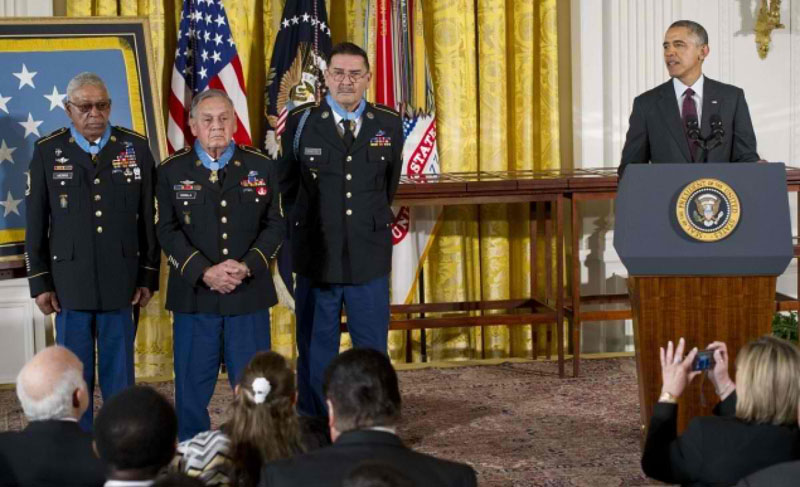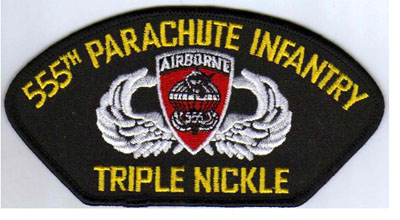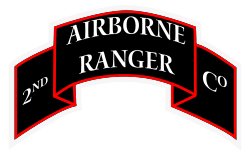By Roy Cook
On March 24, 2014 mostly ethnic or minority U.S. soldiers who performed
bravely under fire in three of the nation's wars finally received the
Medal of Honor that the government concluded should have been awarded
a long time ago.
The servicemen were identified following a congressionally mandated review to ensure that eligible recipients of the country's highest recognition for valor were not bypassed due to prejudice. Only three of the 24 were alive for President Barack Obama to place the medals and ribbons around their necks. The three surviving recipients — Vietnam veterans Jose Rodela, Melvin Morris and Santiago Erevia — received a prolonged standing ovation at President Obama's side, their faces set in somber acknowledgement of the honor.

(AP Photo/Evan Vucci)
Santiago Erevia, of San Antonio, was cited for courage while serving as a radio-telephone operator on May 21, 1969, during a search-and-clear mission near Tam Ky, South Vietnam. He was a specialist 4 when his battalion tried to take a hill fortified by Viet Cong and North Vietnam Army soldiers. The Pentagon says he single-handedly silenced four Viet Cong bunkers.
"I thought I was going to get killed when I started to advance because when you fight battles like that you don't expect to live," the 68-year-old retired postal worker told The Associated Press last month.
Jose Rodela, now of San Antonio, was a 31-year-old company commander of a Special Forces strike group on Sept. 1, 1969, in Phuoc Long Province, Vietnam, when he and his company of Cambodian soldiers whom he had helped recruit came under fire from North Vietnamese Army troops.
According to his Medal of Honor citation and supporting documents, the battle lasted 18 hours and 11 men in his company were killed and 33 others wounded.
The citation states that late in the battle, Rodela "was the only member of his company who was moving and he began to run from one position to the next, checking for casualties and moving survivors into different positions in an attempt to form a stable defense line. Throughout the battle, in spite of his wounds, Rodela repeatedly exposed himself to enemy fire to attend to the fallen and eliminate an enemy rocket position."
In an interview with the Army News Service last December, he said simply, "We trained for this and I would have done it again."
"Today we have the chance to set the record straight," President Obama said. "No nation is perfect, but here in America we confront our imperfections and face a sometimes painful past, including the truth that some of these soldiers fought and died for a country that did not always see them as equal."
U S Army Special Forces and Medal of Honor recipient Melvin Morris was born in Okmulgee, Okla., Jan. 7, 1942.
Morris entered the Oklahoma Army National Guard in 1959 and later requested to join the active Army. He became one of the first Soldiers to don the 'green beret' at the command of President John F. Kennedy, Fort Bragg, N.C., in 1961. Morris volunteered twice for deployments to Vietnam.
Melvin Morris is being recognized for his valorous actions on Sept. 17, 1969, while commanding the Third Company, Third Battalion of the IV Mobile Strike Force near Chi Lang. Then-Staff Sgt. Morris led an advance across enemy lines to retrieve a fallen comrade and single-handedly destroyed an enemy force that had pinned his battalion from a series of bunkers. Staff Sgt. Morris was shot three times as he ran back toward friendly lines with the American casualties, but did not stop until he reached safety.
The Distinguished Service Cross was awarded to then Staff Sgt. Morris in April 1970 for extraordinary heroism during this 1969 battle. After receiving the award, he returned to Vietnam the same month for his second tour. He retired at Fort Hood, Texas in May 1985. Morris currently resides in Cocoa, Fla.
"I never really did worry about decorations," Morris told The Associated Press last month. But he said he fell to his knees when he received the surprise call from President Obama with news that he was to be honored.
|
Staff Sgt. Melvin Morris was awarded the Medal of Honor by President Barack Obama during a ceremony in the East Room of the White House in Washington, Tuesday, March 18, 2014. President Obama awarded 24 Army veterans the Medal of Honor for conspicuous gallantry in recognition of their valor during major combat operations in World War II, the Korean War and the Vietnam War.
|
Additionally, in Camp Mackall, North Carolina the first all-black parachute Infantry platoon was activated on November 25,1944. They would be called the 555th Battalion, a.k.a. “The Triple Nickles.” They were called the Triple Nickles because 17 of 20 soldiers selected from the Buffalo Soldiers 92nd Infantry in Arizona made it through the test platoon at Fort Benning. The unit's name came from the old English spelling and identified with three buffalo nickels joined in a triangle or pyramid.
The Triple Nickles served in more airborne units during both war and peacetime than any other parachute group in history.
|
|
In early 1944 sixteen of these young men completed requisite training, overcoming numerous obstacles, and were awarded the silver wings of qualified parachutist. Shortly thereafter an additional trooper, having been delayed by a family emergency, was also awarded the much coveted parachutist badge. These men were led by former First Sergeant Walter Morris, and went on to form the cadre for the 555th Parachute Infantry Company at Camp Mackall, North Carolina.

Test Platoon - First 16 qualified black paratroopers (1944) Enlisted men of the Test Platoon. Front Row from L-R: First Sgt. Walter Morris, first black enlisted man accepted for airborne duty • Sgt. Jack D. Tillis • Sgt. Leo D. Reed • Sgt Daniel Weil *S. Sgt. Hubert Bridges • Tech. Grade IV Alvin L. Moon • Sgt. Ned D. Bess • Sgt. Roger S. Walden Back Row from L-R • Cpl. McKinley Godfrey, Jr. • Sgt. Elijah Wesby • Sgt. Samuel W. Robinson • S. Sgt. Calvin R. Beal • S. Sgt Robert F. Greene • S. Sgt. Lonnie M. Duke • Sgt. Clarence H. Beavers and Sgt. James E. Kornegay. Not Shown Carstell O. Stewart, the seventeenth, who was on emergency leave and earned his wings a week later.
|
The Officers of the test platoon (1944) Left to Right • First Lt. Jasper E. Ross, Chicago, IL • Second Lt. Clifford Allen, Chicago, IL • Second Lt. Bradley Biggs, Newark, NJ • Second Lt. Edwin H. Wills, Washington, DC • Second Lt. Warren C. Cornelius, Atlantic City, NJ • Second Lt. Edward Baker, Chicago, IL |
Several weeks after the "Test Platoon" graduated; six black officers also completed training and were awarded parachutists badges. Prominent among the six was Second Lieutenant Bradley Biggs
Now that the gates were open, a veritable flood of young black men volunteered for parachute training, causing the rapid evolvement of the seventeen enlisted men and six officers into the 555th Parachute Infantry Company and the 555th Parachute Infantry Battalion, which was attached to the 82nd Airborne Division at Fort Bragg, North Carolina.
On a cold day in December, 1947, teary eyed members of the "Triple Nickles" Battalion stood in mass formation as this proud, one of a kind battalion was deactivated and all assigned soldiers transferred in grade and rank to the 3rd Battalion, 505th Parachute Infantry Regiment 82nd Airborne Division, thus becoming the first black unit in history to become a part of an American combat division. This historic milestone was presided over by then Major General James M. "Jumping Jim" Gavin, a much admired and respected World War II Commander. General Gavin, because of his effort in bringing "Triple Nickles" into the mainstream, will always be revered by members of the 555th Parachute Infantry Association.
The 555th Parachute Infantry Battalion subsequently provided personnel for formation of the 503rd Airborne Anti-Aircraft Battalion and the 80th Airborne Ant-Aircraft Battalion.
|
|
Activated and trained as a successor organization to the 2nd Ranger Battalion from World War II, the 2nd Ranger Company was formed and trained extensively in airborne warfare. Deployed to South Korea in December 1950, the company quickly adopted the motto of "Buffalo Rangers" and worked extensively as a scouting force for the U.S. 7th Infantry Division. In this role, the company undertook several major operations against the Chinese People's Volunteer Army, including Operation Tomahawk in early 1951.
Even though racial politics often resulted in the company receiving untrained replacements, it performed well in many small-scale engagements during this time. In the summer of 1951, the company was employed along the front line as an advance force to push back Chinese attacks as the front lines became more static. The company was highly regarded for its actions capturing and holding Hill 581 during the Battle of the Soyang River, in which the company inflicted hundreds of casualties on the Chinese without a single Ranger being killed
Finally, recognition at last!
Among those who received a posthumous medal was Leonard Kravitz, an assistant machine gunner in the Korean War who is credited with saving his platoon by providing cover for retreating troops. He died in the attack. He is the uncle of singer and actor Lenny Kravitz, who attended Tuesday's ceremony.
President Obama singled out a childhood friend of the elder Kravitz, Mitchel Libman, for making a mission of upgrading medals for deserving soldiers.
"He and his wife Marilyn spent years writing letters and working with Congress and our military to get this done," President Obama said.
Tuesday's mass ceremony, the largest since World War II, was the result of an Army review conducted under a directive from Congress in the 2002 National Defense Authorization Act. The law required that the record of each Jewish-American and Hispanic-American veteran who received a Service Cross during or after World War II be reviewed for possible upgrade to the Medal of Honor. Of the two dozen, 18 are Latinos.
The Pentagon said the Army reviewed the cases of the 6,505 recipients of the Distinguished Service Cross from World War II and the Korean and Vietnam wars and found an eligible pool of 600 soldiers who may have been Jewish or Hispanic. The Army also worked with the National Museum of American Jewish Military History, the Jewish War Veterans of the USA and the American GI Forum, the largest Hispanic-American veterans group, to pinpoint potential medal recipients.
During the initial review, investigators found that other soldiers who had received the Distinguished Service Cross appeared to meet the criteria for a Medal of Honor and the directive was expanded to permit them to be considered for the upgraded honor.
These were heroes who didn't get their recognition due to bias or politics of the times.
Source: Jim Kuhnhenn, Associated Press. Also: 555 LTC (Ret.) Bradley Biggs, 1SG (Ret.) Walter Morris, and CW4 (Ret.) Fred Farmer.



